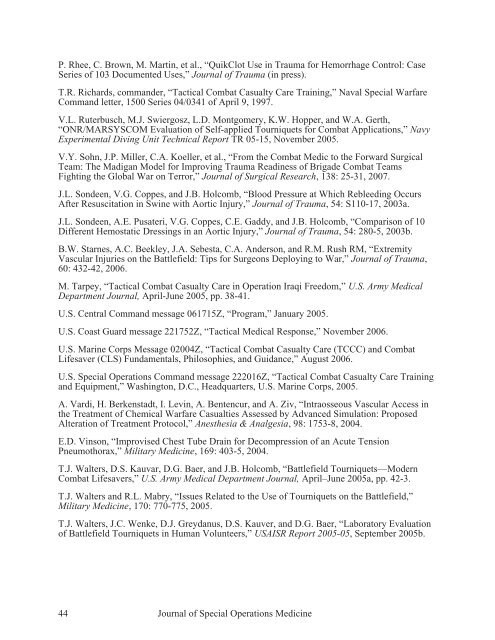Training Supplement - United States Special Operations Command
Training Supplement - United States Special Operations Command
Training Supplement - United States Special Operations Command
Create successful ePaper yourself
Turn your PDF publications into a flip-book with our unique Google optimized e-Paper software.
P. Rhee, C. Brown, M. Martin, et al., “QuikClot Use in Trauma for Hemorrhage Control: Case<br />
Series of 103 Documented Uses,” Journal of Trauma (in press).<br />
T.R. Richards, commander, “Tactical Combat Casualty Care <strong>Training</strong>,” Naval <strong>Special</strong> Warfare<br />
<strong>Command</strong> letter, 1500 Series 04/0341 of April 9, 1997.<br />
V.L. Ruterbusch, M.J. Swiergosz, L.D. Montgomery, K.W. Hopper, and W.A. Gerth,<br />
“ONR/MARSYSCOM Evaluation of Self-applied Tourniquets for Combat Applications,” Navy<br />
Experimental Diving Unit Technical Report TR 05-15, November 2005.<br />
V.Y. Sohn, J.P. Miller, C.A. Koeller, et al., “From the Combat Medic to the Forward Surgical<br />
Team: The Madigan Model for Improving Trauma Readiness of Brigade Combat Teams<br />
Fighting the Global War on Terror,” Journal of Surgical Research, 138: 25-31, 2007.<br />
J.L. Sondeen, V.G. Coppes, and J.B. Holcomb, “Blood Pressure at Which Rebleeding Occurs<br />
After Resuscitation in Swine with Aortic Injury,” Journal of Trauma, 54: S110-17, 2003a.<br />
J.L. Sondeen, A.E. Pusateri, V.G. Coppes, C.E. Gaddy, and J.B. Holcomb, “Comparison of 10<br />
Different Hemostatic Dressings in an Aortic Injury,” Journal of Trauma, 54: 280-5, 2003b.<br />
B.W. Starnes, A.C. Beekley, J.A. Sebesta, C.A. Anderson, and R.M. Rush RM, “Extremity<br />
Vascular Injuries on the Battlefield: Tips for Surgeons Deploying to War,” Journal of Trauma,<br />
60: 432-42, 2006.<br />
M. Tarpey, “Tactical Combat Casualty Care in Operation Iraqi Freedom,” U.S. Army Medical<br />
Department Journal, April-June 2005, pp. 38-41.<br />
U.S. Central <strong>Command</strong> message 061715Z, “Program,” January 2005.<br />
U.S. Coast Guard message 221752Z, “Tactical Medical Response,” November 2006.<br />
U.S. Marine Corps Message 02004Z, “Tactical Combat Casualty Care (TCCC) and Combat<br />
Lifesaver (CLS) Fundamentals, Philosophies, and Guidance,” August 2006.<br />
U.S. <strong>Special</strong> <strong>Operations</strong> <strong>Command</strong> message 222016Z, “Tactical Combat Casualty Care <strong>Training</strong><br />
and Equipment,” Washington, D.C., Headquarters, U.S. Marine Corps, 2005.<br />
A. Vardi, H. Berkenstadt, I. Levin, A. Bentencur, and A. Ziv, “Intraosseous Vascular Access in<br />
the Treatment of Chemical Warfare Casualties Assessed by Advanced Simulation: Proposed<br />
Alteration of Treatment Protocol,” Anesthesia & Analgesia, 98: 1753-8, 2004.<br />
E.D. Vinson, “Improvised Chest Tube Drain for Decompression of an Acute Tension<br />
Pneumothorax,” Military Medicine, 169: 403-5, 2004.<br />
T.J. Walters, D.S. Kauvar, D.G. Baer, and J.B. Holcomb, “Battlefield Tourniquets—Modern<br />
Combat Lifesavers,” U.S. Army Medical Department Journal, April–June 2005a, pp. 42-3.<br />
T.J. Walters and R.L. Mabry, “Issues Related to the Use of Tourniquets on the Battlefield,”<br />
Military Medicine, 170: 770-775, 2005.<br />
T.J. Walters, J.C. Wenke, D.J. Greydanus, D.S. Kauver, and D.G. Baer, “Laboratory Evaluation<br />
of Battlefield Tourniquets in Human Volunteers,” USAISR Report 2005-05, September 2005b.<br />
44 Journal of <strong>Special</strong> <strong>Operations</strong> Medicine

















